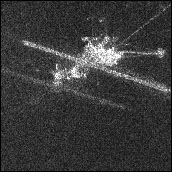There are two types of remote sensing instruments—passive and active.
Passive instruments detect natural energy that is reflected or emitted
from the observed scene. Passive instruments sense only radiation
emitted by the object being viewed or reflected by the object from a
source other than the instrument. Reflected sunlight is the most common
external source of radiation sensed by passive instruments. Scientists
use a variety of passive remote sensors.
Radiometer
An instrument that quantitatively measures the intensity of
electromagnetic radiation in some band of wavelengths in the spectrum.
Usually a radiometer is further identified by the portion of the
spectrum it covers; for example, visible, infrared, or microwave.
Imaging Radiometer
A radiometer that includes a scanning capability to
provide a two-dimensional array of pixels from which an image may be
produced is called an imaging radiometer. Scanning can be performed
mechanically or electronically by using an array of detectors.
Spectrometer
A device designed to detect, measure, and analyze the
spectral content of the incident electromagnetic radiation is called a
spectrometer. Conventional, imaging spectrometers use gratings or prisms
to disperse the radiation for spectral discrimination.
Spectroradiometer
A radiometer that can measure the intensity of radiation in multiple
wavelength bands (i.e., multispectral). Oftentimes the bands are of a
high spectral resolution—designed for the remote sensing of specific
parameters such as sea surface temperature, cloud characteristics, ocean
color, vegetation, trace chemical species in the atmosphere, etc.
Active instruments provide their own energy (electromagnetic radiation)
to illuminate the object or scene they observe. They send a pulse of
energy from the sensor to the object and then receive the radiation that
is reflected or backscattered from that object. Scientists use many
different types of active remote sensors.
Radar (Radio Detection and Ranging)
A radar uses a transmitter operating at either radio or microwave
frequencies to emit electromagnetic radiation and a directional antenna
or receiver to measure the time of arrival of reflected or backscattred
pulses of radiation from distant objects. Distance to the object can be
determined since electromagnetic radiation propagates at the speed of
light.
Scatterometer
A scatterometer is a high frequency microwave radar
designed specifically to measure backscattered radiation. Over ocean
surfaces, measurements of backscattered radiation in the microwave
spectral region can be used to derive maps of surface wind speed and
direction.
Lidar (Light Detection and Ranging)
A lidar uses a laser (light
amplification by stimulated emission of radiation) to transmit a light
pulse and a receiver with sensitive detectors to measure the
backscattered or reflected light. Distance to the object is determined
by recording the time between the transmitted and backscattered pulses
and using the speed of light to calculate the distance traveled. Lidars
can determine atmospheric profiles of aerosols, clouds, and other
constituents of the atmosphere.
Laser Altimeter
A laser altimeter uses a lidar (see above) to measure the height of the
instrument platform above the surface. By independently knowing the
height of the platform with respect to the mean Earth's surface, the
topography of the underlying surface can be determined.
next: NASA Remote Sensing Accomplishments
back: Color Images
|
 Remote Sensing
Introduction and History
Radiation
Electromagnetic Spectrum
Absorption Bands and
Atmospheric Windows
Spectral Signatures
Pixels and Bits
Color Images
Remote Sensing Methods
NASA Remote Sensing
Accomplishments
References
Related Data Sets:
Observation Deck


This pair of images demonstrates some of the differences between passive
and active sensors. The top image is an aerial photograph (which records reflected
light) of Amundsen-Scott Station, a research facility built on the South Pole.
The bottom image is the same area, at approximately the same scale and orientation,
from RADARSAT. RADARSAT uses active remote sensing—microwaves are generated by the
sensor, reflected from the Earth's surface and back to the sensor. The radar image reveals
an abandoned cluster of buildings (to the lower left of the bright dome) that are now buried
under Antarctic ice. (RADARSAT image courtesy Canadian Space Agency)
| 

